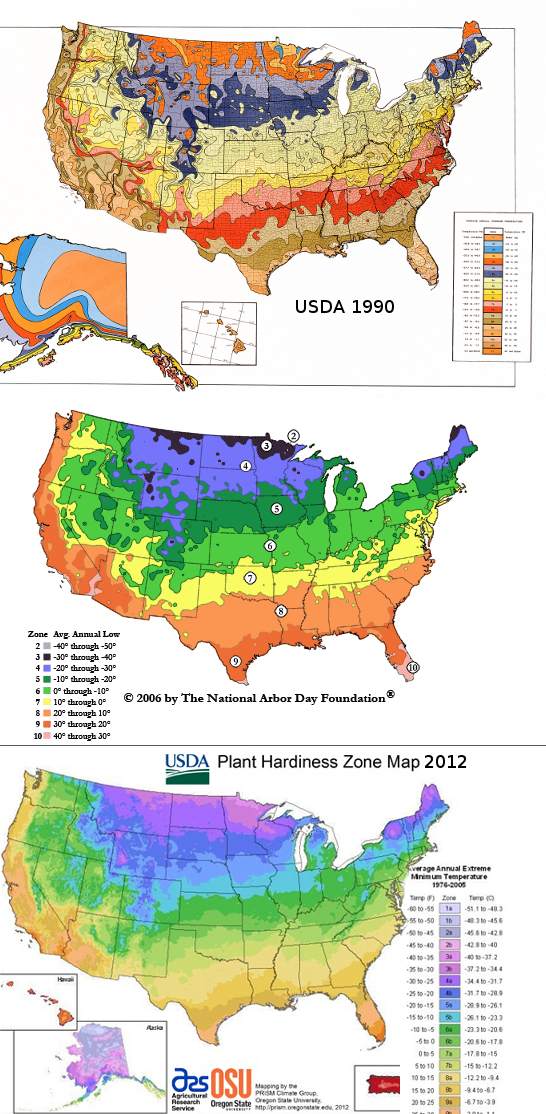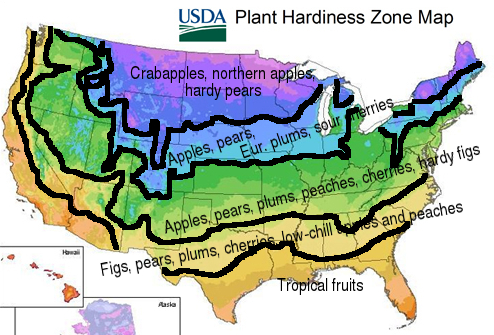
Planting fruit trees in a changing climate
 First the Arbor Day Foundation and then the USDA
came out with revised hardiness maps during the past decade, responding
to our changing climate. And in both cases, the maps promise that our
farm has moved to a warmer place. But can we take their recommendations
as gospel?
First the Arbor Day Foundation and then the USDA
came out with revised hardiness maps during the past decade, responding
to our changing climate. And in both cases, the maps promise that our
farm has moved to a warmer place. But can we take their recommendations
as gospel?
Depending on which map
you consider, our farm could have moved from zone 6a to zone 6b or
even to zone 7, with average annual extreme minimums of -10 to -5, -5 to 0,
and 0 to 5 respectively. However,
given the data of the last two years --- with annual minimums of -12
and -22 --- we might be smarter looking for plants that can handle zone
5b or even zone 4b, suggesting that our winters have become colder
rather than more mild. Granted, each zone's
annual minimums are supposed to be averages only, so it's somewhat
normal to exceed those minimums from time to time. Still, two years in a
row of deep-freeze conditions begins to look like a trend.
I posted before about Logsdon's recommendations for easy fruit tree species by zone,
with the map below summarizing the author's recommendations. If
we're moving a zone or two north, though, that would mean Japanese
plums, peaches, sweet cherries, and hardy figs all drop off the easy
list, leaving us with only apples, pears, European plums, and sour
cherries to savor. Similarly, blackberries, rabbiteye blueberries, and
hardy kiwis might all become dicey if the current trend toward arctic
blasts continues.

Which isn't to say that we won't be able to grow the dropped species at all. However, our sun trap
along the south face of the trailer might become prime real estate for
plants that have become a gamble from a climatic standpoint, and we
might eventually have to admit that peaches and figs in the main part of
the garden are doomed to failure.
Or maybe these brief cold spells won't have the same effect as a full
zone 5 winter. Only time will tell. But I do recommend keeping track of
your annual minimum temperatures and also perusing both of the new
hardiness-zone maps...especially if, like Karen B.,
you're planning to put in $928 worth of fruit trees. If nothing else,
stick to spring planting for questionable species, and plant your
charges in well-drained soil shielded from wind and in an area exposed
to the maximum amount of winter sun. Here's hoping all of your fruit
trees --- and mine too --- are surviving this long, cold winter.
Want more in-depth information? Browse through our books.
Or explore more posts by date or by subject.
About us: Anna Hess and Mark Hamilton spent over a decade living self-sufficiently in the mountains of Virginia before moving north to start over from scratch in the foothills of Ohio. They've experimented with permaculture, no-till gardening, trailersteading, home-based microbusinesses and much more, writing about their adventures in both blogs and books.
Want to be notified when new comments are posted on this page? Click on the RSS button after you add a comment to subscribe to the comment feed, or simply check the box beside "email replies to me" while writing your comment.

I know that there are so many different kinds of berries that Scandinavians use--esp. blueberries! Also that gooseberries and currants are so often grown both in New England and in England, besides blueberries, which are so prevalent in Maine. Also Alpine strawberries must be hardy. I also read of a peach orchard in Ipswich, Mass.--tho that was in the 30s, I think. And, as you did mention earlier, the trick is to somehow keep the fruit trees from budding too soon, esp. in a mid-winter thaw. Maybe one trick with peaches wd be to plant them in shadier places, which, because seemingly colder, might hold them back, and might even protect them. As for blueberries, I think the "low-bush" are actually hardier, tho I haven't looked it up. As for apples: maybe New England types are better, to try.
Interesting post. I do hope your figs and other trees will survive this cold. Any you guys too. Our house stays around 55-58, but 40 degrees inside would be uncomfortable! I dont know what rabbiteye blueberries are, but blueberries grow wild here in zone 5, so maybe, even with colder winters, they would still be an option for you. I just finished shoveling and snowshoeing a path to three maples in more tnan thigh deep snow In preparation for tapping. Forecast next week looks good. This snow will definitely limit the number of taps we drill.... it is just too hard to get to the trees! (Its the reason of course why most of the old trees were planted along roadways)
Some of the most delicious blueberries I've had were growing wild in northern Minnesota, and the bramble fruits at my parents' house in Wisconsin are pretty good, too. Seed catalogs originating from the colder zones actually have a pretty good selection of berries and fruits, so don't despair!
I agree it will be interesting to see how the changing weather patterns (or variability [un-patterns?], I suppose) affect perennial plant survivability. Looking forward to your meticulous notes on the matter!